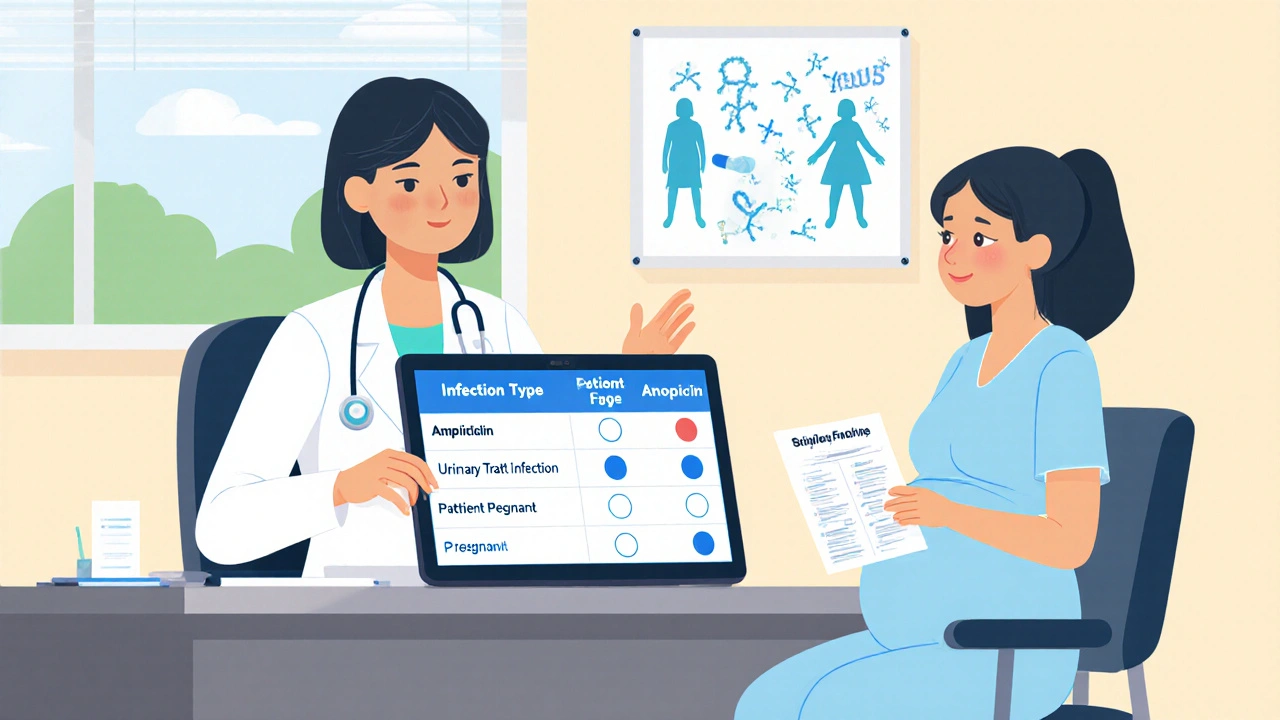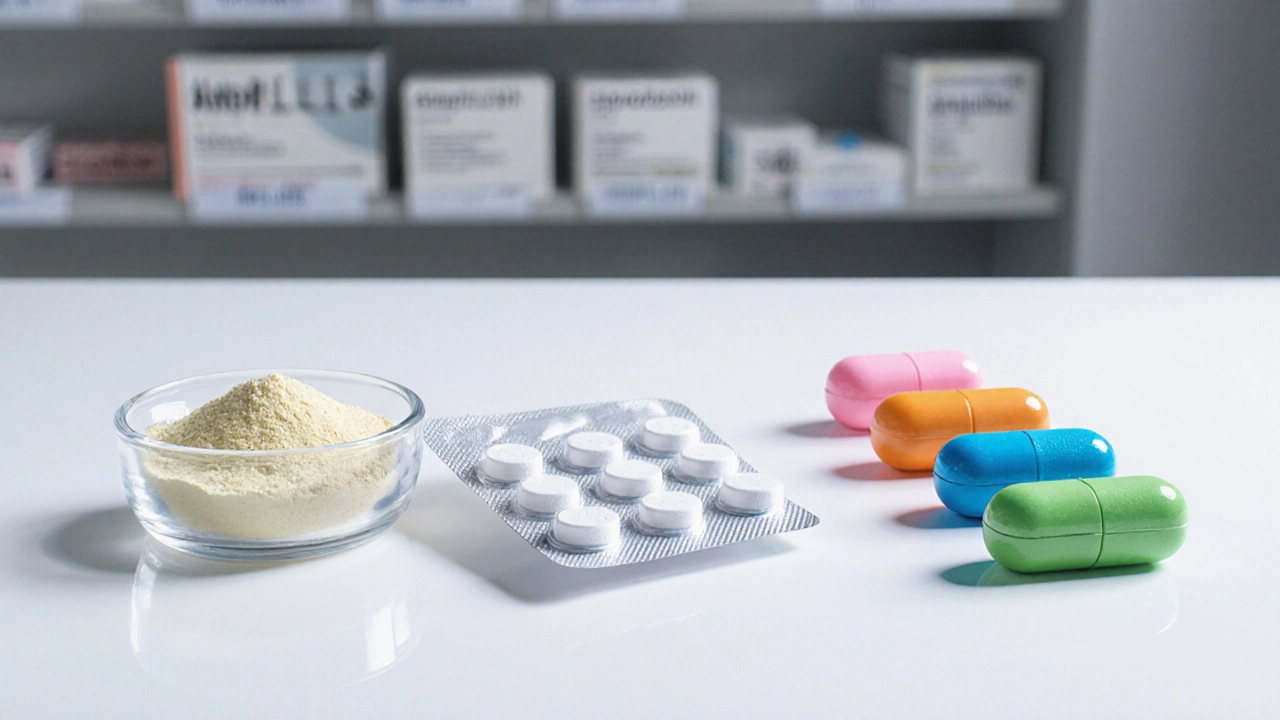Ampicillin vs Alternative Antibiotics Decision Guide
Ampicillin (Acillin)
Best for: UTIs, meningitis, salmonella infections. Safe in pregnancy.
- Good Gram-positive coverage
- Low cost
- IV/oral interchangeability
Amoxicillin
Best for: Respiratory infections, skin infections.
- Better oral absorption
- Often combined with clavulanate
- Less GI irritation
Ciprofloxacin
Best for: Complicated UTIs, respiratory infections.
- Broad Gram-negative coverage
- Once daily dosing
- Caution in tendon issues
Clinical Guidance:
Select infection type and patient factors to get personalized recommendations.
Comparison Table
| Attribute | Ampicillin | Amoxicillin | Cephalexin | Ciprofloxacin | Azithromycin |
|---|---|---|---|---|---|
| Class | Penicillin | Penicillin | Cephalosporin | Fluoroquinolone | Macrolide |
| Oral Bioavailability | ≈30% | ≈90% | ≈90% | ≈70% | ≈50% |
| Key Coverage | Gram-positive, some Gram-negative | Gram-positive, some Gram-negative | Staphylococcus, Streptococcus | Broad Gram-negative | Atypicals, some Gram-positive |
| Indications | UTI, meningitis, salmonella | Ear, sinus, dental infections | Skin infections, prophylaxis | Complicated UTIs, prostatitis | Pneumonia, chlamydia |
When doctors need a reliable, broad‑spectrum penicillin, they often reach for Ampicillin (marketed as Acillin). It’s been a workhorse since the 1960s, yet a slew of newer agents compete for the same infections. This guide breaks down how ampicillin stacks up against the most common alternatives, helping clinicians, students, and patients pick the right pill for the right bug.
How Ampicillin Works
Ampicillin belongs to the beta‑lactam family. It attacks the bacterial cell wall by binding to penicillin‑binding proteins (PBPs), halting peptidoglycan cross‑linking and causing the cell to burst. Because the drug targets a structure absent in human cells, it’s generally safe, but resistant organisms that produce beta‑lactamases can blunt its effect.
Key Attributes of Ampicillin (Acillin)
- Spectrum: Effective against many Gram‑positive streptococci, susceptible Enterococcus faecalis, some Haemophilus influenzae, and select Enterobacteriaceae (e.g., Escherichia coli).
- Typical Dosage: 250mg-1g orally every 6hours; 1-2g IV every 4-6hours for severe infections.
- Pharmacokinetics: Well‑absorbed orally (≈30% bioavailability), renal excretion, half‑life ≈1hour in healthy adults.
- Common Side Effects: Gastro‑intestinal upset, rash, occasional eosinophilia; rare but serious Clostridioides difficile colitis.
- Resistance Concerns: β‑lactamase production (especially TEM‑1), altered PBPs in some Streptococcus pneumoniae strains.
Frequently Used Alternatives
Below are the top five antibiotics clinicians consider when ampicillin isn’t ideal. Each entry includes a brief description and its primary clinical niche.
- Amoxicillin is a penicillin derivative with better oral absorption and a similar spectrum, often paired with clavulanic acid to overcome β‑lactamases.
- Penicillin G (benzyl‑penicillin) remains the drug of choice for susceptible streptococci and syphilis, but it lacks activity against many Gram‑negative organisms.
- Cephalexin is a first‑generation cephalosporin that covers most staphylococci and streptococci, with added stability against many β‑lactamases.
- Ciprofloxacin is a fluoroquinolone offering broad Gram‑negative coverage, excellent tissue penetration, and once‑daily dosing, but it carries a risk of tendon injury.
- Azithromycin is a macrolide with a long half‑life, useful for atypical pathogens and patients with penicillin allergy.
Side‑by‑Side Comparison
| Attribute | Ampicillin (Acillin) | Amoxicillin | Penicillin G | Cephalexin | Ciprofloxacin | Azithromycin |
|---|---|---|---|---|---|---|
| Class | Penicillin (β‑lactam) | Penicillin (β‑lactam) | Penicillin (β‑lactam) | Cephalosporin (β‑lactam) | Fluoroquinolone | Macrolide |
| Oral Bioavailability | ≈30% | ≈90% | IV/IM only | ≈90% | ≈70% | ≈50% |
| Key Gram‑Positive Coverage | Streptococcus spp., Enterococcus faecalis | Streptococcus spp., Enterococcus spp. | Streptococcus pyogenes, Treponema pallidum | Staphylococcus aureus (including some β‑lactamase producers) | Limited; some Staphylococcus aureus | Streptococcus pneumoniae (if susceptible), atypicals |
| Key Gram‑Negative Coverage | H. influenzae, susceptible E. coli, Proteus mirabilis | H. influenzae, susceptible E. coli | Very limited | Some E. coli, Klebsiella (low) | Broad: Pseudomonas, Enterobacteriaceae, Haemophilus | Limited; can cover some H. influenzae |
| Typical Indications | UTI, meningitis, intra‑abdominal infections, salmonella | Middle ear infections, sinusitis, dental abscess | Strep throat, syphilis, prophylaxis for rheumatic fever | Skin and soft‑tissue infections, prophylaxis before surgery | Complicated UTIs, prostatitis, intra‑abdominal infections | Community‑acquired pneumonia, chlamydia, bronchitis |
| Major Side Effects | GI upset, rash, C. difficile risk | Similar to ampicillin, less GI irritation | Allergic reactions, Jarisch‑Herxheimer | Diarrhea, allergic rash | Tendon rupture, QT prolongation | GI upset, QT prolongation |
| Resistance Issues | β‑lactamase production, PBP alterations | β‑lactamase (often overcome with clavulanic acid) | β‑lactamase, rare resistance | Extended‑spectrum β‑lactamases (ESBL) limit use | Efflux pumps, target‑site mutations | Macrolide‑inducible resistance (erm genes) |

Decision Criteria: When to Reach for Ampicillin
Pick ampicillin if you need a cheap, IV‑orally interchangeable drug that covers both Gram‑positive streptococci and select Gram‑negative bugs. It shines in:
- Hospital‑acquired meningitis caused by susceptible Enterococcus.
- Salmonella enterica infections where a penicillin‑type agent is sufficient.
- Pregnant patients needing a Category B drug with a known safety record.
Skip it when:
- The suspected pathogen produces β‑lactamase (e.g., many H. influenzae strains).
- You need strong activity against Pseudomonas aeruginosa - ciprofloxacin or an anti‑pseudomonal β‑lactam is required.
- The patient has a documented penicillin allergy; a macrolide or a third‑generation cephalosporin (if cross‑reactivity is low) may be safer.
Pros and Cons at a Glance
| Pros | Cons |
|---|---|
| Low cost; widely available in both oral and IV forms. | Susceptible to β‑lactamase degradation; limited activity against many resistant Gram‑negatives. |
| Well‑studied safety profile; safe in pregnancy. | Oral bioavailability is modest, requiring higher doses for systemic infection. |
| Effective for a range of intra‑abdominal and urinary infections. | Higher risk of C. difficile colitis compared with some newer agents. |
Practical Tips for Prescribing Ampicillin
- Confirm local susceptibility patterns - many UK hospitals still report >80% susceptibility for E. coli urinary isolates.
- If β‑lactamase production is likely, add a β‑lactamase inhibitor (e.g., sulbactam) or switch to amoxicillin‑clavulanate.
- Adjust dose in renal impairment: reduce on creatinine clearance <30mL/min.
- Monitor for rash in patients with a history of drug allergy; document any reaction promptly.
- Educate patients to complete the full course, even if symptoms improve, to lower resistance pressure.
Frequently Asked Questions
Can I take ampicillin with food?
Food doesn’t significantly affect absorption, but taking it with a full glass of water reduces stomach irritation.
Is ampicillin safe during pregnancy?
Yes. It’s classified as Category B in the UK, meaning animal studies haven’t shown fetal risk and there are no adequate human studies, but clinical experience supports its use when needed.
How does ampicillin differ from amoxicillin?
Both are penicillins, but amoxicillin has ~90% oral bioavailability and a slightly broader Gram‑negative spectrum. Ampicillin is preferred when IV therapy is required because it can be given intravenously without formulation changes.
What should I do if I develop a rash while on ampicillin?
Stop the medication and contact your prescriber immediately. A rash may signal an allergic reaction, which could progress to anaphylaxis if re‑exposed.
Why does ampicillin have a higher risk of C. difficile infection?
Broad‑spectrum agents disturb the normal gut flora more than narrow‑spectrum drugs, allowing C. difficile spores to proliferate. Using the shortest effective course and reserving ampicillin for cases where its spectrum is truly needed helps mitigate this risk.
Next Steps & Troubleshooting
If you’ve chosen ampicillin but culture results later show a β‑lactamase‑producing organism, switch to amoxicillin‑clavulanate or a third‑generation cephalosporin. For patients who can’t tolerate penicillins, azithromycin or a fluoroquinolone (if no contraindications) may be viable alternatives. Always re‑evaluate therapy after 48-72hours based on clinical response and lab data.
By weighing spectrum, route, safety, and local resistance patterns, you can decide whether ampicillin (Acillin) remains the best fit or if one of its alternatives offers a clearer advantage for your patient’s infection.




